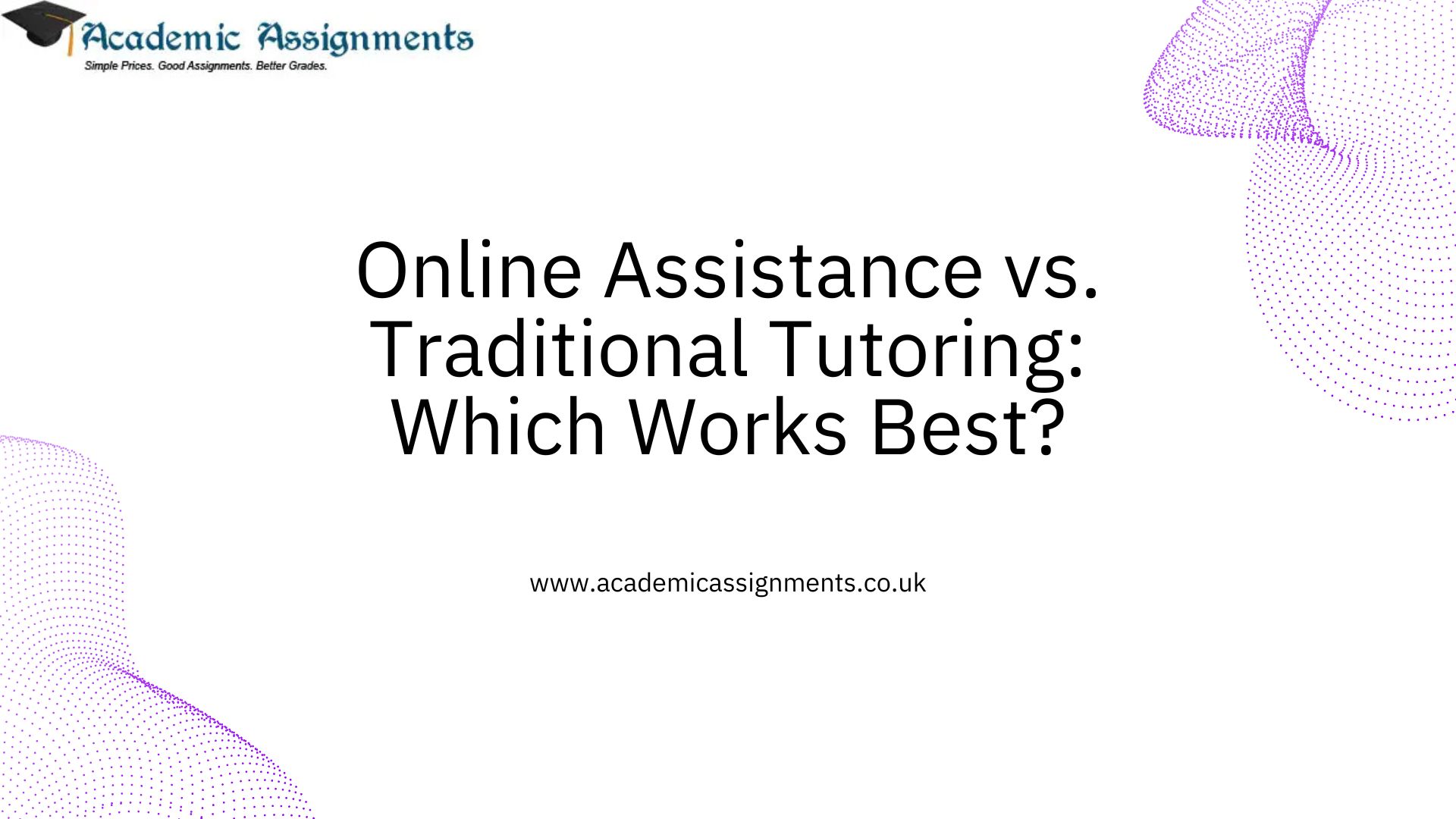Online Assistance vs. Traditional Tutoring: Which Works Best?
In today’s world, students confront various obstacles that limit their potential in academic facilities. These are limited time, poor grasp of concepts, and other intercalated activities among them time limitations. To this end, many students use academic help. While traditional tutoring has long been the go-to option, the advent of technology has introduced a powerful alternative: online academic assistance. This article discusses both options and then considers which is more effective for students.
Flexibility and Accessibility
Flexibility is one of the main benefits of online academic help services. In a virtual learning environment, students can get resources and support whenever they want and wherever they are. This is especially significant for students working while attending school, with other commitments such as sports or children and families. On the other hand, conventional face-to-face tutelage is timed, and at times entails physical commuting which can inconvenience students with strict schedules. Mass data confirms that more than 60% of learners across the globe value flexible timetables, a study carried out by the Education Technology Association in 2023 showed. Such a transition to online solutions drives the need for the verification of educational solutions that address learning needs.
Personalized Learning Experience
Face-to-face learning characteristic of traditional tutoring may be preferred because it tends to create a certain level of trust between the learner and tutor. It enables face-to-face response in the form of gestures and expounding as well as illustration. But, online assignment solutions also accomplish different learning procedures and methods with the help of advanced algorithms and artificial intelligence. Most internet-based communities employ artificial intelligence to study students’ performance, targeting the content in their most precarious areas. According to the EdSurge report published in 2022, students who have used AI in learning instructional software to improve their understanding of previously challenging areas had a 73 % increase.
Cost Effectiveness
In many cases, cost is a defining consideration when approaching any plan of action to contribute to intellectual development. Private coaching can be costly because tutors charge per hour which can range between $30 and $80 depending on the tutor’s qualifications together with the region. On the other hand, remote learning help is more affordable. Websites often use membership approaches where one pays a user fee to get a variety of tools that may otherwise be costly when hired by personal senators. Furthermore, some of these online services have extras such as videos, and self-assessment quizzes which makes it worth the investment. This availability makes virtual options more desirable especially for students from low-income backgrounds.
Variety of Learning Tools
In traditional teaching, learning resources encompass textbooks, writing boards, and verbal instructions. Although useful in many situations, these methods are not always productive and may be difficult to motivate. On the other hand, virtual academic help in the form of video tutorials, animation, and learning games, spices up studying making it a lot more fun. For instance, such platforms as Khan Academy and Coursera incorporate the use of figures and icons together with real-world scenarios. Source: Journal of Educational Psychology Learner’s exposure to multimedia increases their learning by thirty percent.
Team help for tasks
The inability to meet assignment deadlines has always remained a big issue among students. Class tutors are not always available to give instant assistance especially because of time differences. This is where online assignment help come out on top. Most of the platforms are available round the clock with an opportunity to meet with the experts and clear all the misunderstandings. For instance, Chegg or TutorMe allows you to send questions and get answers and detailed explanations within several hours. At this level of accessibility, students are never caught up with topsy turvy due to unmet deadlines which in turn increases their self-esteem and overall performance.
Human Relations and Social Contact
There might be a disadvantage in remote learning help, which consists of the absence of social contacts. In general, the traditional approach to tutoring helps them to feel like members of a group, and that is motivating. Student sessions that enable students to at least share ideas with fellow students make it difficult to allow online learning and teaching. However, most online environments are beginning to contain discussion boards, virtual discussion groups, and live online sessions. These features provide social interaction points where students can interact with fellow students as well as with the instructors, which is an important social aspect missing from online classes.
Accountability and Discipline
Guided learning may have more chances to develop increased levels of responsibility since the methods of personal communication are accompanied by more rigorous expectations. Students cannot afford to miss sessions or come prepared very badly knowing that there is a tutor who is expecting to see them in person. On the other hand, virtual academic help entails more self-discipline than physical academic help. Some learners need bodily guidance, and even though a tutor is not around, they may find it hard to remain focused. However, many online platforms now employ the concept of gamification and tutorial progress bars to assist students in staying motivated.
Technological Barriers
It’s difficult to overemphasize the positive effects of technology in the sphere of online academic help but technology is a two-sided weapon. Some students are likely to have no access to computers, smartphones, or any other devices required for the use of online options. The UNESCO report of a global survey of students conducted in 2021 showed that as many as 37% of them either had no internet connection or inadequate access, the main concern related to virtual learning. On the other hand, conventional tutoring does not involve the use of technology and therefore can be more effective in reaching out to the underprivileged students. Although, as the world is now trying to reduce the digital divide more and more parties get connected to the internet introducing online solutions.
Academic Performance Outcomes
Online help and explicit tuition also benefit university academic performance. To some extent, research shows that online assignment solutions are a hair more efficient. The 2023 Online Learning Consortium also revealed that students who engaged in OSAS had a 15% higher rating in their standard tests as compared to the basic techniques. The difference here could be explained by the availability of a variety of resources and multiple exposures to the material, which, in turn, cannot be easily incorporated into the tutoring process.
Environmental Impact
One of the areas not often considered is the impact the execution of each method will have on the environment. Face-to-face teaching and learning entail travel, paper, and fixed structures which in one way or another are environmentally unfriendly. On the other hand, Remote learning help is less of a sustainable process as no traveling is involved and there is less paperwork. This is so especially when placed alongside the current push for educating for sustainability.
Combining Both Approaches
In general, the best outcome is realized when face-to-face learning is complemented by online learning by those students who can afford it. The integration of the features of traditional tutoring with a focus on the interaction of the academic assistant and the student on the one hand and the use of the internet to bring convenience and organizational easiness on the other hand results in a perfect learning system. An integrated approach enables learners to gain from the advantages of the two techniques and at the same time, overcome the weaknesses that are associated with the two.
Conclusion
Overall, from the entire discussion, it can be said that the tutorial mode of learning and online academic help differ primarily in the approach to learning the material, and their selection will depend on the learner’s preferences, needs, and conditions. More conventional solutions give the client an individual approach and direct contact with the manager, but solutions that are online allow for cost-effective and equipped working. That is why with gradual changes in technology, internet services available for work are more and more powerful, which allows us to use them for the work of most students. Finally, the idea is to choose a learning solution that fits every need of a learner and assists one in accomplishing his/her academic goals.

 Blogs
Blogs





